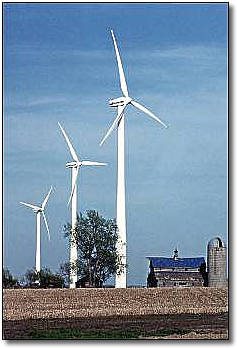Record low costs helped drive U.S. utility-scale onshore wind development to all-time highs in employment and capacity, according to a new federal Department of Energy report.
The U.S. land-based wind industry installed 7,588 MW of capacity last year, bringing the overall utility-scale total to more than 96 GW. Employment in the sector is also at an historic support of 114,000 jobs.
“Onshore wind energy installation continues to grow across the country, and this Administration has proven that we can pursue renewable energy advancements and deployment, particularly wind energy resources, which are predicted to surpass other sources of renewable power generation this year,” said Under Secretary of Energy Mark W. Menezes. “And with over 25 GW in the development pipeline, U.S. offshore wind is poised to be a significant part of our comprehensive energy portfolio in the coming years.”
The 2018 Wind Technologies Market Report, prepared by DOE’s Lawrence Berkeley National Laboratory, also found the following:
- In total, 41 states operated utility-scale wind projects. Texas leads the nation with nearly 25 GW of wind capacity, while California, Iowa, Kansas, and Oklahoma have more than 5 GW.
- Wind energy provides 6.5 percent of the nation’s electricity, more than 10 percent of total generation in 14 states, and more than 30 percent in Iowa, Kansas, and Oklahoma.
- The price of wind energy being sold in long-term contracts is at an all-time low. Wind power purchase agreement (PPA) prices are below 2 cents per kWh, driven by a combination of higher capacity factors, declining turbine prices and operating costs, low interest rates, and the production tax credit.
The nationwide query also found that the trend of using larger wind turbines was sustained last year. The average capacity of large-scale turbines installed in distributed applications in 2018 was 2.1 MW—almost double the capacity of turbines used in 2003.
Commercial and industrial distributed wind projects increased in 2018, representing 29 percent of total project capacity. Distributed wind for utility customers remained the most prevalent use, representing 47 percent of capacity in 2018.
Of small wind turbines (nameplate capacity up to 100 kilowatts) deployed in the United States, very small turbines—less than 1 kW— are contributing an increasingly larger percentage of both the total number of turbines (99 percent) and capacity (47 percent) of small wind projects. These systems are often used for battery charging and are sometimes integrated with solar PV panels to power remote infrastructure.
(Rod Walton is content director for Power Engineering and POWERGEN International. He can be reached at 918-831-9177 and rod.walton@clarionevent.com).




